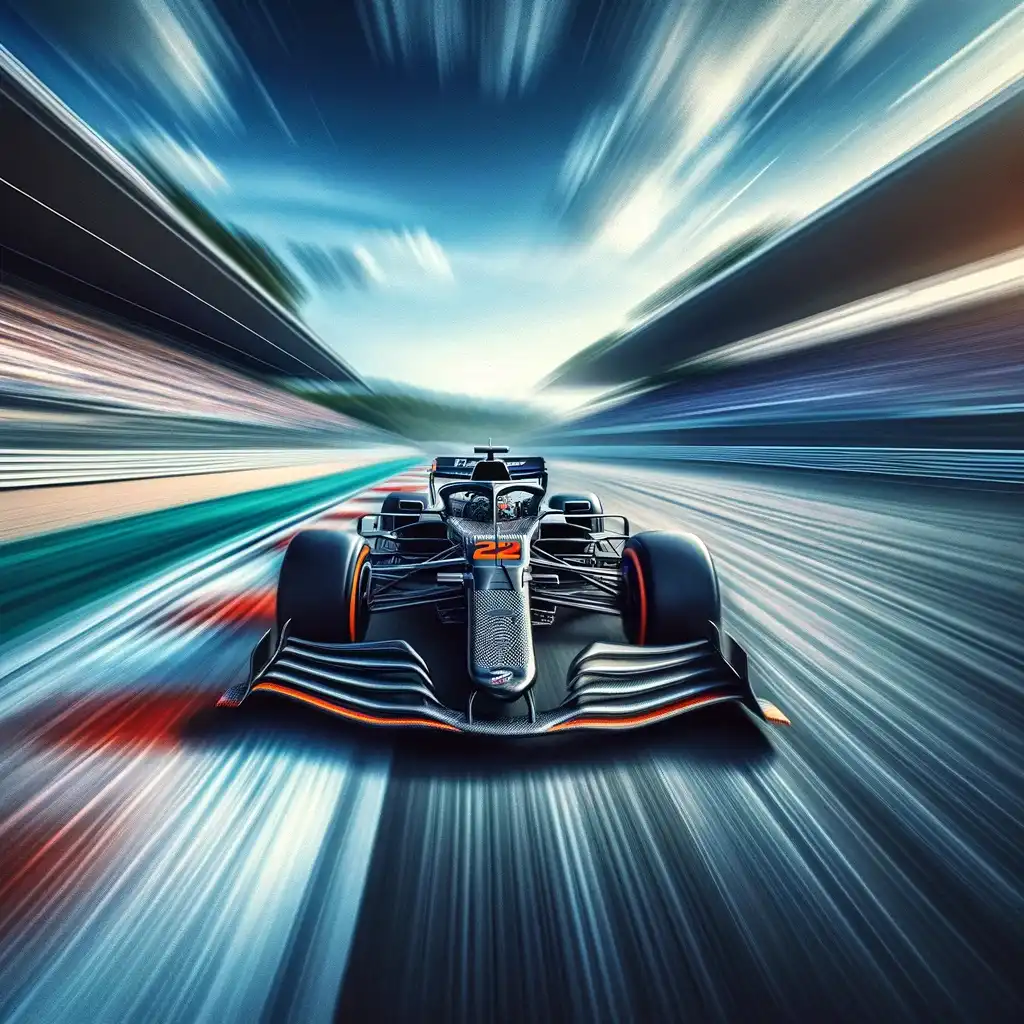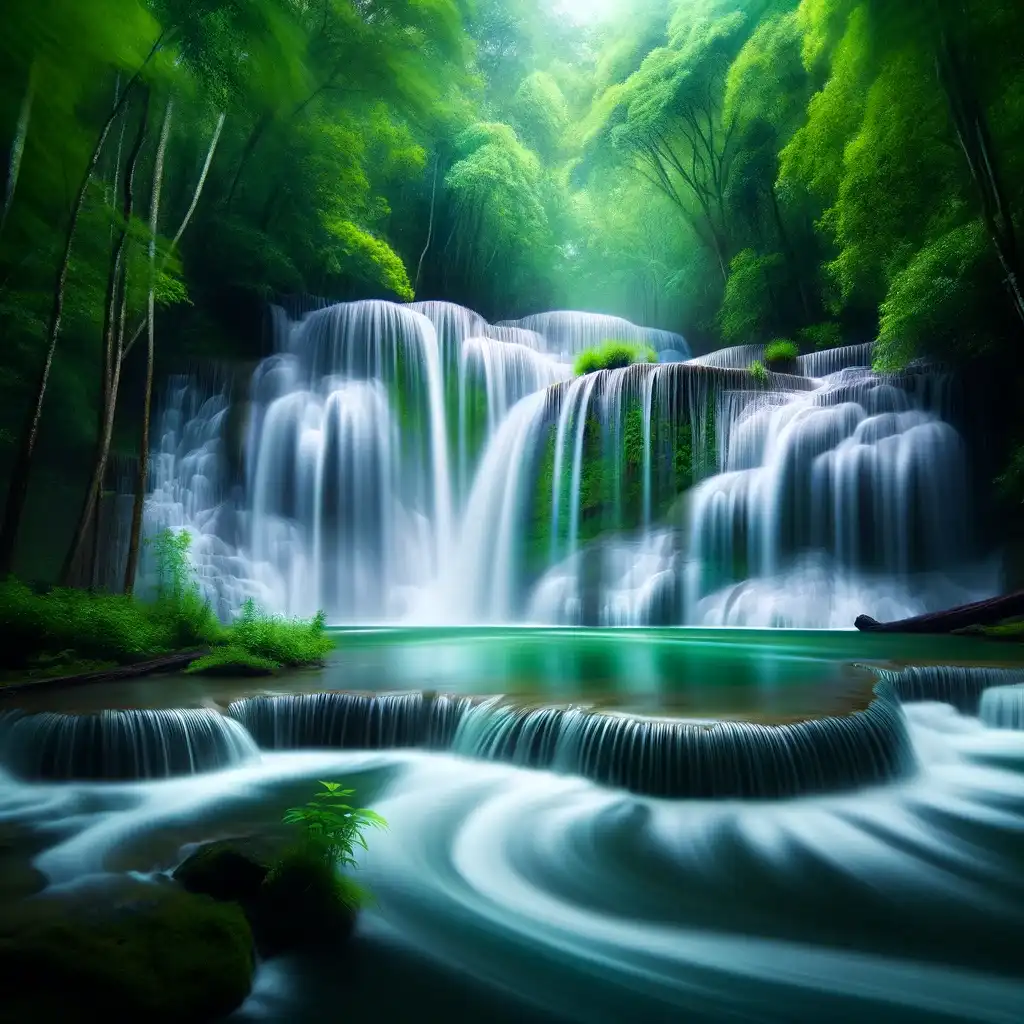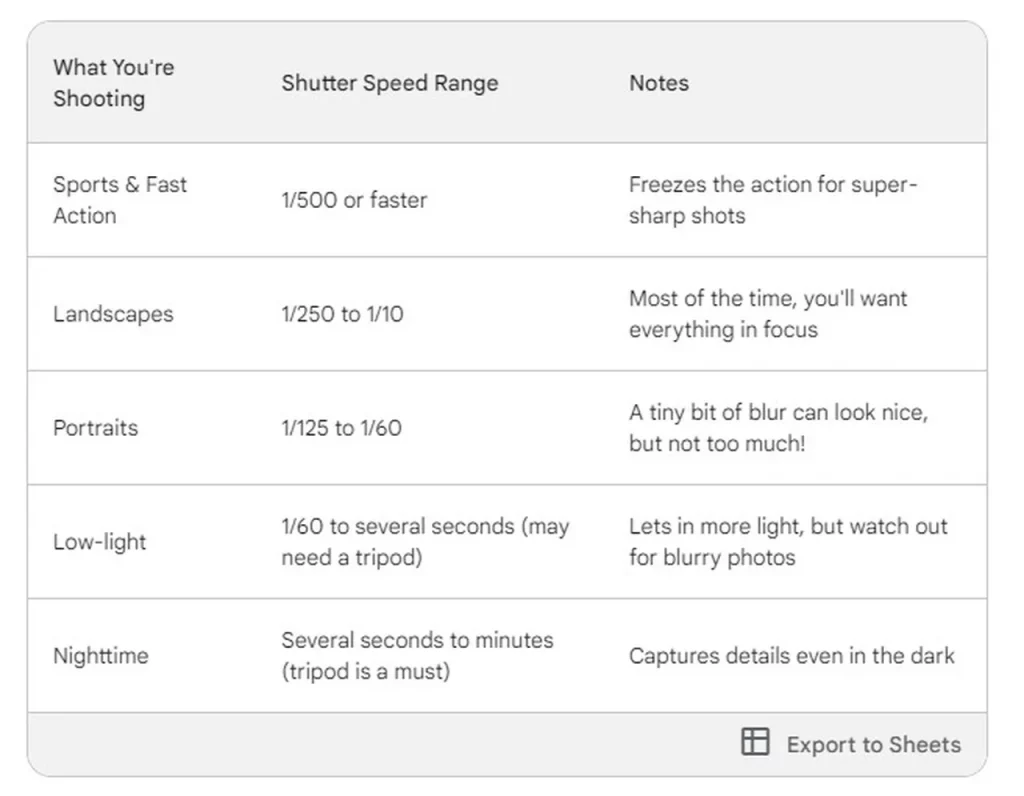Master motion in your photography with shutter speed charts! Learn how to freeze action, blur movement, and get perfectly exposed photos.
In the world of photography, shutter speed is like a super important camera setting. It’s how long your camera “sees” the scene when you snap a picture. Getting the hang of shutter speed means you control how bright your photos are AND whether things look frozen or blurry. A shutter speed chart is your secret weapon for becoming a shutter speed boss!
What is a Shutter Speed Chart?
Think of a shutter speed chart as your guide to all the different “blink speeds” your camera can use. It shows a bunch of common shutter speeds and what they do to your photos. This helps you choose the perfect speed for the kind of picture you want to take.
Why is a shutter speed chart important?
A shutter speed chart is important for several key reasons:
Learning Tool:
- See the Big Picture: A chart shows all the common shutter speeds in order. It makes it super clear how each speed lets in more or less light than the next.
- Get the Idea: The chart connects shutter speed directly to your photos – want things sharp or blurry? Is the image too bright or dark? The chart helps you understand why.
Practical Applications:
- Your Pocket Guide: Shooting outdoors and not sure what shutter speed to use? A quick look at the chart gives you a starting point.
- Predict the Future: As you practice, the chart helps you visualize what a photo will look like before you even press the button.
Taking Control
- Intentional Choices: Tired of your camera’s auto mode making all the decisions? The chart lets you choose the right shutter speed for the look you want.
- Freeze It or Blur It: Want to capture a bird taking off or show the silky flow of a waterfall? The chart is your guide to controlling movement.
- Exposure Triangle Master: Shutter speed is just one piece of getting a perfect photo. The chart helps you see how it works with other settings (aperture and ISO) for the right level of brightness.
Basically, a shutter speed chart is like leveling up your photography skills. You’ll go from snapping random shots to creating exactly the images you have in mind!
Shutter Speed – Your Time Machine for Photos
Imagine your camera’s shutter is a super-fast door for light. Shutter speed is how long that door stays open when you take a photo. It’s like your camera has magic powers:
Freeze the Action!
- Fast shutter speeds, like 1/1000 of a second, are like hitting the pause button on the world. Perfect for catching a bird taking off, a race car zooming by, or even just your friend jumping for joy!

Creating Blur
- Slow shutter speeds, like 1/30 of a second or longer, let you show how things move. Think of a waterfall – with a slow shutter speed, it looks like a silky white flow. Or cars on a busy street at night become cool streaks of light!

The Exposure Triangle:
Teamwork Makes the Dream Work Shutter speed is just one part of getting perfectly bright photos. Here’s the camera settings team:
- Shutter Speed: How long light gets in.
- Aperture: How big the opening is for light (like the pupil of your eye!)
- ISO: How sensitive your camera is to light.
Shutter Speed Chart in Action

Shutter Speed Cheat Sheet
Want to know the right shutter speed for different situations? Here’s a quick guide to get you started:
Get Creative: Play with Shutter Speed
- Panning: Imagine following a cyclist with your camera as they ride by. Use a slower shutter speed, and the cyclist will be fairly sharp, but the background will be a cool blur. It makes them look super fast!
- Long Exposure: Think of those dreamy photos where waterfalls look like silky white streaks, or you see trails of light from cars on a highway. That’s all done with long exposures – shutter speeds of several seconds or more!
Tips:
- These are starting points – experiment to find what works best for you!
- A tripod comes in handy for slow shutter speeds, especially at night.
Tips to Keep in Mind
Understanding Your Camera’s Limits
- Know Your Camera’s Limits: While shutter speed charts are super helpful, every camera is a little different. Most can’t take pictures faster than a tiny fraction of a second (like 1/4000 or 1/8000 of a second). They also have limits with really slow shutter speeds, usually topping out around 30 seconds. Check your camera’s instruction book if you want to know the exact limits.
The Tech Inside
Why Camera Shutter Speeds Have Limits:
- Mechanical Shutters: Think of these like tiny curtains inside your camera that open and close to let light in. Most DSLRs and some mirrorless cameras use these, but the curtains can only move so fast!
- Electronic Shutters: Newer mirrorless cameras often have these. They don’t actually have curtains, using electronics instead. This means they can go incredibly fast, but sometimes they make fast-moving objects look a bit distorted.
- Super Long Exposures – Bulb Mode: Want a photo that takes longer than 30 seconds? Most cameras have “Bulb” mode. This keeps the shutter open as long as you hold the button down – awesome for those cool nighttime shots.
The Power of Image Stabilization
- Image Stabilization: Ever had a blurry photo because your hands were a bit shaky? Image stabilization (IS) to the rescue! It’s basically a way to make up for tiny movements in the camera. Some cameras have this built right in, others have it in specific lenses. Think of it like giving you an extra “stop” or two, so you can use slightly slower shutter speeds and still get sharp pictures.
Practice Makes Perfect
Want to be a shutter speed master? Get out there and experiment! Try these:
- Motion and Speed: Find something moving (friend running, a car, water, etc.). Start with a super-fast shutter speed, then gradually slow it down. See how the movement looks totally different?
- Lighting Conditions: Take the same photo at different times of day. Did you notice how shutter speed changes depending on how much light there is?
- Tripod vs. No Tripod: Take a photo with a slow shutter speed. Try it once with a tripod, then again holding the camera. See how much sharper the tripod picture is? That’s the power of image stabilization!
How do You read a shutter speed chart?
Think of a shutter speed chart like a speed limit sign for light! Here’s how it works:
- Top = Super Fast: The top of the chart shows those super-speedy shutter speeds (like 1/1000, 1/2000 of a second). These are like lightning-fast blinks for your camera, great for freezing action.
- Bottom = Slow Down: As you move down the chart, the shutter speeds get slower (like 1/30, 1/4 of a second, or even multiple seconds). This means the camera’s “eye” stays open longer.
- The Brightness Factor: The longer your camera’s “eye” is open, the more light gets in, which means a brighter photo. So, going down the chart = brighter image.
Example:
Let’s say you start with a shutter speed of 1/250 of a second. If you change it to 1/125 of a second (one step down on the chart), your photo will be twice as bright!
Tips:
- Charts Can Vary: Some charts show more shutter speeds than others. Don’t worry, the basic idea is the same!
- Practice Makes Perfect: The best way to get it is to grab your camera and start experimenting with different shutter speeds. See how they change your photos!
Note about AI Detectors: While these tips can help your writing sound more natural, there’s no guaranteed way to beat AI detection. Make your goal to create awesome content for real people!
When would We use a fast shutter speed?
Imagine your camera shutter is like a super-fast eyelid. A fast shutter speed is a lightning-quick blink! Here’s when you want that speedy blink:
- Freeze the Action! Trying to capture a soccer player scoring a goal, a bird taking flight, or your dog doing a jump? A fast shutter speed (like 1/500 of a second or even faster) will freeze the movement super sharp. No more blurry messes!
- Handheld Hero: Even if you have steady hands, there’s always a tiny bit of shake when holding a camera. A fast shutter speed helps reduce that blur, so your photos come out crisp.
Think about it this way: The faster something is moving, the faster you want your shutter speed to be in order to catch it clearly.
When Slow Shutter Speeds are Your Friend
Think of slow shutter speeds as keeping your camera’s “eye” open for a longer time. Here’s why that’s sometimes awesome:
- Make Things Blurry (On Purpose!): Want to make a waterfall look like a silky white flow? Or turn the headlights of cars into cool streaks of light? Slow shutter speeds are your tool to create that motion blur.
- See in the Dark: Shooting at night or in a dim room? A slow shutter speed lets in more light, so you can get a decent photo without making your ISO super high (which can make images grainy).
- Important Note: Get Steady! Slow shutter speeds mean any little shake of your hand will show up as blur. A tripod is usually a must to keep things sharp!
Extra Tip: The slower you want your shutter speed, the brighter the scene needs to be, otherwise your photo will be way too bright.
Conclusion
Understanding shutter speed charts is a game-changer for your photography. You’ll have the power to freeze a magical moment or show the dynamic flow of the world around you. So grab your camera, experiment, and see what amazing images you can create!”
Ready to dive deeper? Explore our guide to aperture and how it works with shutter speed!”
Do you have any favorite shutter speed tricks or stunning photos showcasing motion? Share them in the comments below!

The content creator team at calipsotree.com is dedicated to making topics accessible to everyone, with over 9 years of experience in writing and breaking down complex concepts into easy-to-understand articles that answer readers’ financial questions.








